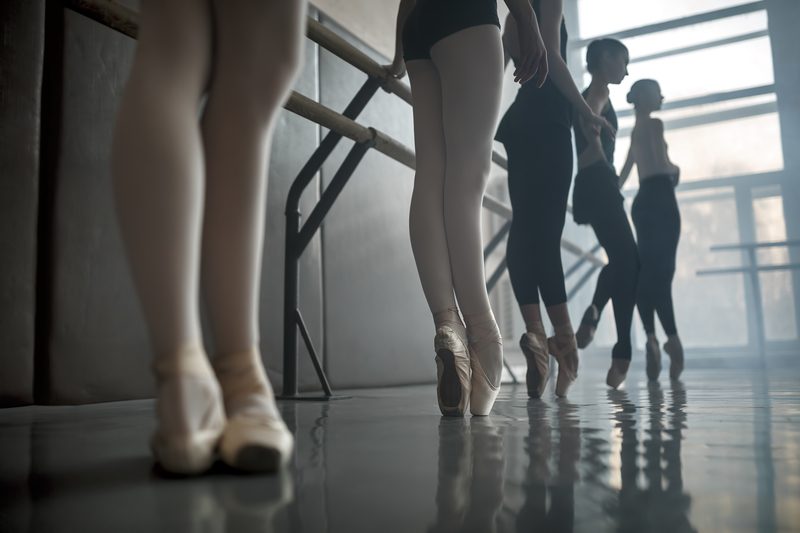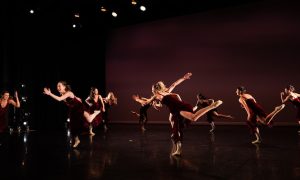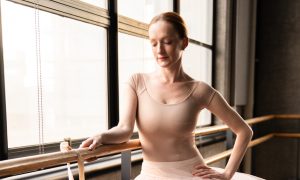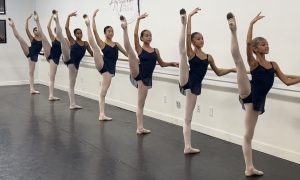Most young ballerinas dream of someday going en pointe. Pointe shoes are beautiful – new and shiny – and pointe dancers look otherworldly – graceful and ethereal. But some young dancers may be scared or nervous about going en pointe because of myths and misconceptions about pointe work. Here, we clarify 10 lies about pointe work and uncover the truth.
#1. Pointe shoes are made of wood or ceramic. That sounds like it would hurt!
TRUTH: They may be hard, but pointe shoes are certainly not made out of wood. Pointe shoes are generally handmade using many materials – layers of fabric and glue, covered in satin, with a hard leather sole. When the glue dries, it becomes hard and provides the stiffness and support. As hard as they are, however, they’re more pliable than wood, which allows your feet to roll up and down, all the while being supported up en pointe.
#2. As soon as I turn 12, I’m ready for pointe.
TRUTH: There is no across-the-board age when dancers are ready for pointe. It depends entirely on strength, technique, frequency of study and a teacher or doctor’s approval. Don’t be discouraged if your friend gets her pointe shoes before you; rather, work hard, don’t give up, and prove to your teacher that you’re ready, too.
#3. My favorite dancer wears “x” brand pointe shoes, so I want to wear those, too.
TRUTH: The brand, style and fit of your pointe shoe is a very individual decision. Each dancer’s body and feet are different and will have different needs in terms of a pointe shoe. It’s best to see a professional pointe shoe fitter for a consultation and to get a knowledgeable, educated suggestion on what pointe shoe may be best for you.
#4. Pointe work will damage my feet and toes.
TRUTH: You can still have healthy, clean, “normal-looking” feet as a pointe dancer. It’s all about taking care of your feet – both in the shoe and out. Foot conditions such as bunions and blisters have a variety of causes. Sometimes, bunions are hereditary. In some cases, bunions and blisters are caused by poorly fitted pointe shoes, shoes that are too small or improper alignment en pointe. Some products, such as such as bunion cushions (available at any drugstore), Spacers and Jelly Tips, can help alleviate pressure and friction on your toe joints and bunions. Be careful not to overpad and overcrowd your toes, though, as that will just put more pressure on your toes. And practice good hygiene with your feet as well. Sometimes an Epsom salt bath or ice bath for your feet is the best way to end a long dance day!
#5. Men can’t dance en pointe.
TRUTH: While pointe work was originally left up to the ladies, nowadays many men dance en pointe. Companies exist such as Les Ballets Trockadero de Monte Carlo, Les Ballets Grandiva and Les Ballets Eloelle, and these companies are exclusively male dancers who perform en pointe. Some would even say that certain steps – traveling steps such as piqué turns and chainés, for instance – are sometimes easier for a man to execute en pointe than a woman. And some male dancers are breaking the mold further and performing in female roles in some major ballet companies! If you don’t already, be sure to follow Chase Johnsey and Jayna Ledford.
#6. Once you’ve done pointe, you can stand up on your toes without the pointe shoes.
TRUTH: Pointe shoes are designed specifically to encase your toes and support your foot when en pointe. It is not advisable to go on your toes in any other shoe (or barefoot) that isn’t specially designed to support you in that position.
#7. One pair of pointe shoes will last me all year.
TRUTH: There’s no set lifeline for a pair of pointe shoes. How long a pair lasts will be different for each dancer, for each style of shoe, and will even fluctuate depending on the repertory or amount of class work that you’re dancing. Although it is possible to extend the life of a pointe shoe with products such as Jet Glue, it is important to pay attention to your shoes and when they become too soft or “dead”. Dancing on shoes that aren’t able to support your feet and ankles can lead to injury. Ask a teacher if you’re unsure whether it’s time for a new pair.
#8. I can wear pointe shoes brand new out of the box.
TRUTH: You need to sew on ribbons and elastic before you start dancing en pointe. Not only do ribbons and elastic hold on the shoe to your foot and prevent the heel from slipping out, but they also provide ankle support when you stand en pointe. Each dancer may discover a personal way to stitch her ribbons and elastic, and some dancers also like to bend the shank a bit or press on the box for a little more give before their first wear. Ask your teacher or a professional pointe shoe fitter for suggestions on a “breaking in” process. And check out resources like Dancewithmary NYC for excellent pointe shoe tricks and tips.
#9. Being en pointe will feel as good as it looks.
TRUTH: Yes, professional ballerinas can make pointe work look easy, but they’ve been doing it for years and work hard daily to perfect their craft. When you first go en pointe, it may feel uncomfortable. It’s a new sensation, and you’re not used to putting weight on your toes. It takes getting used to, but don’t be discouraged if it’s not “easy” and “pain-free” right away.
#10. Anyone can go en pointe – no strength or training needed – because the shoe holds you up.
TRUTH: While pointe shoes are designed to support and encase your toes, feet and ankles, they’re not magic devices that will hold you up effortlessly. It takes much strength, core work and technique to dance en pointe. Work hard in your ballet classes, and keep up with your core conditioning and other exercises, and that will translate over to your pointe work.
By Laura Di Orio of Dance Informa.















